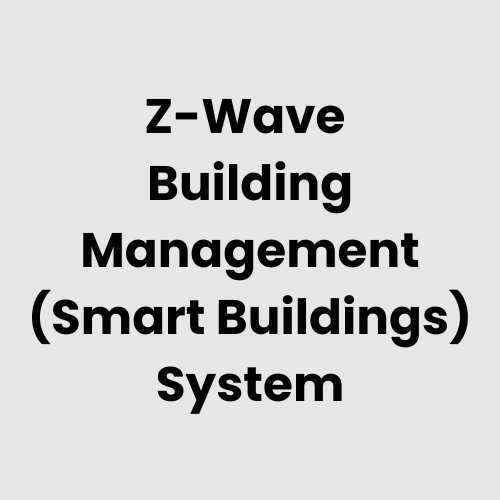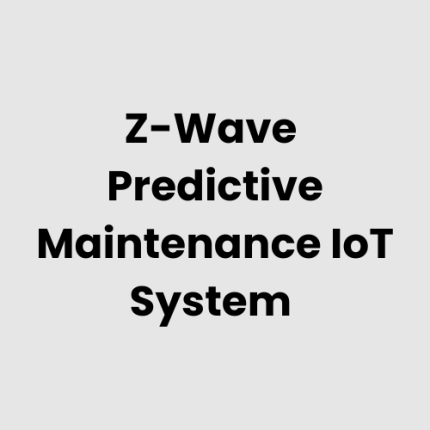Description
Z-Wave Enabled Smart Building Management (Smart Buildings) System
The Z-Wave Enabled Smart Building Management system utilizes an integrated network of smart devices and sensors to optimize building operations. The core components of the system include Z-Wave-enabled devices for controlling lighting, heating, ventilation, air conditioning (HVAC), security, and other building systems. These devices communicate over a Z-Wave mesh network, providing seamless and scalable integration. The architecture consists of
- Sensors and Actuators: Monitoring and controlling environmental factors such as temperature, humidity, occupancy, lighting, and security.
- Z-Wave Gateway: Acts as a central controller that manages and connects devices to the cloud or local server.
- Cloud Integration: Allows remote access to data and control of building systems.
- Data Analytics and Reporting: Monitors performance, energy usage, and security, offering actionable insights to optimize efficiency.
List of Hardware for Z-Wave Enabled Smart Building Management System
- Z-Wave Sensors: Motion, temperature, humidity, light, occupancy, and environmental sensors.
- Smart Thermostats: For automated heating and cooling based on occupancy and weather conditions.
- Smart Lighting: Dimmable and motion-detecting lighting systems for energy efficiency and convenience.
- Smart Locks: For remote door access control and enhanced security.
- Smart HVAC Controllers: For regulating heating, cooling, and ventilation based on real-time data.
- Smart Plugs and Outlets: For controlling power supply to various appliances and equipment.
- Z-Wave-enabled Security Cameras: For real-time monitoring and integration with building security systems.
- Z-Wave Gateway/Hub: Acts as the bridge between devices and the cloud or local server.
- Energy Meters: For tracking energy consumption and providing insights to optimize efficiency.
Physical Placement Considerations of the Hardware
The proper placement of hardware components is crucial for optimal performance and coverage in a smart building. Key considerations include:
- Sensor Placement: Ensure sensors are placed in areas with optimal coverage, such as hallways, entryways, and common areas, while avoiding obstructions.
- Gateway Location: Position the Z-Wave gateway in a central location to ensure a strong and reliable mesh network connection to all devices.
- Security Devices: Install security cameras and smart locks near entry points and high-value areas to enhance building security.
- Lighting and HVAC Systems: Position thermostats and light sensors strategically in rooms or areas with varying temperature and lighting needs.
- Energy Monitoring Devices: Place energy meters at key power entry points to accurately track building-wide energy consumption.
Hardware Architecture of Z-Wave Enabled Smart Building Management System
The hardware architecture consists of interconnected devices that work in tandem to create a smart building environment:
- Edge Devices: These include sensors, thermostats, and smart plugs, which collect data or perform actions based on specific environmental factors. They communicate with the Z-Wave gateway via the mesh network.
- Z-Wave Gateway: Central hub responsible for managing communication between edge devices and the cloud or local server.
- Cloud Platform/Local Server: Collects and processes data from edge devices. It can also provide remote monitoring and control features for building managers.
- Mobile/Control Interfaces: Allows building managers to interact with the system remotely via mobile applications or web dashboards.
Deployment Considerations of Z-Wave Enabled Smart Building Management System
When deploying the Z-Wave Enabled Smart Building Management system, consider the following factors:
- Network Coverage: Ensure the Z-Wave mesh network covers the entire building with minimal dead zones. Deploy repeaters if necessary to boost signal strength.
- Device Compatibility: Ensure all devices selected for deployment are compatible with the Z-Wave protocol to ensure seamless integration.
- Security Measures: Implement robust security protocols to protect building data and prevent unauthorized access, especially for devices controlling access points.
- Scalability: Design the system to scale as the building’s needs grow, such as adding more sensors or devices in the future without compromising system performance.
- Energy Efficiency: Leverage energy-efficient devices to reduce overall power consumption and optimize operational costs in the long term.
List of Relevant Industry Standards and Regulations
- ISO 50001: Energy management systems.
- ASHRAE 90.1: Energy standard for buildings.
- LEED: Leadership in Energy and Environmental Design certification.
- IEEE 802.15.4: Standard for low-rate wireless personal area networks.
- EN 50090: Home and Building Electronic Systems (HBES) standard.
- UL 294: Standard for access control systems.
- BICSI 002: Data Center Design and Implementation.
Local Server Version of Z-Wave Enabled Smart Building Management System
In a local server deployment, all data from Z-Wave devices are processed on-premises rather than in the cloud. This approach offers the following benefits:
- Enhanced Security: Data is stored and processed locally, which can provide more stringent control over building data and reduce exposure to external threats.
- Reliability: A local server can continue to operate in case of internet or cloud service disruptions, ensuring uninterrupted control of building systems.
- Faster Response Time: Local processing minimizes latency, enabling real-time control of building systems.
Cloud Integration and Data Management
Cloud integration allows building managers to access and control the Z-Wave Enabled Smart Building Management system from anywhere in the world. Key aspects include:
- Remote Access: Users can monitor and control devices through a secure cloud portal or mobile app.
- Data Storage and Analytics: The cloud stores historical data from devices, which can be analysed to optimize energy usage, improve security, and forecast future operational needs.
- Real-time Data Processing: Cloud platforms can process real-time data, generating insights and automating actions such as adjusting HVAC settings or turning off lights when rooms are unoccupied.
- Scalability: The cloud enables easy scalability for adding devices, new building locations, or integrating with other building systems.
At GAO Tek Inc., we provide end-to-end solutions for implementing Z-Wave Enabled Smart Building Management System, offering expert guidance and support in every phase of the project, from design and deployment to ongoing management and optimization. With our deep expertise in IoT and smart building technologies, we help transform buildings into efficient, sustainable, and secure spaces.
GAO Case Studies
- New York City, NY
A high-rise building in New York City utilized Z-Wave technology to automate its lighting, HVAC, and security systems. The integration improved energy efficiency and reduced operational costs by enabling remote monitoring and control through a centralized system. - Chicago, IL
A commercial office complex in Chicago integrated Z-Wave devices for advanced building management. This included automated lighting and climate control, enhancing tenant comfort while significantly lowering energy consumption and maintenance costs. - San Francisco, CA
In San Francisco, a luxury residential building adopted Z-Wave-enabled automation for lighting and HVAC systems. The smart system allowed residents to control their environment from mobile apps, boosting convenience and energy savings. - Los Angeles, CA
An office building in Los Angeles implemented a Z-Wave-based solution for building automation. The system controlled lighting, security, and energy management systems, offering real-time insights that allowed for operational optimizations and better energy consumption tracking. - Dallas, TX
A multi-use commercial facility in Dallas deployed a Z-Wave-enabled building management system, automating key functions like heating, cooling, and lighting. The integration helped reduce energy waste and increased building security with smarter surveillance. - Houston, TX
In Houston, a corporate campus adopted Z-Wave technology to optimize its energy usage across multiple buildings. The smart systems monitored air quality, lighting, and climate, adjusting based on real-time data to improve comfort and efficiency. - Miami, FL
A luxury hotel in Miami integrated Z-Wave devices for guest room automation, allowing guests to control lighting, climate, and security from their smartphones. This resulted in an enhanced guest experience and lower energy bills for the hotel. - Washington, D.C
A mixed-use development in Washington, D.C. leveraged Z-Wave-enabled building management systems for energy monitoring, automated lighting, and remote HVAC control. The system led to better tenant satisfaction and reduced energy consumption across the property. - Atlanta, GA
In Atlanta, GA, a large office building implemented Z-Wave smart devices for automated climate control and lighting. The systems were able to adjust based on occupancy patterns, reducing energy waste and improving tenant comfort. - Seattle, WA
A prominent commercial building in Seattle adopted Z-Wave for its integrated building management system, optimizing energy use across HVAC and lighting systems. The system also featured remote monitoring capabilities, improving response times to maintenance needs. - Boston, MA
A university campus in Boston implemented Z-Wave-enabled sensors and controls to manage lighting, HVAC, and water usage across multiple buildings. This helped the campus improve sustainability while lowering operational costs. - Philadelphia, PA
In Philadelphia, an office building implemented Z-Wave automation for energy management. The system monitored and controlled HVAC, lighting, and security systems, resulting in energy savings and improved building performance. - Denver, CO
A commercial office building in Denver utilized Z-Wave-enabled smart devices to automate its lighting and HVAC systems. By optimizing energy consumption based on real-time data, the building achieved greater sustainability and efficiency. - Phoenix, AZ
A mixed-use building in Phoenix adopted Z-Wave technology for smarter control of its lighting, HVAC, and security systems. The integration led to significant energy savings while enhancing building security and tenant satisfaction. - Minneapolis, MN
A large retail center in Minneapolis used Z-Wave smart building management technology to automate lighting, climate control, and security systems. The system resulted in lower maintenance costs and a better overall customer experience.
Canada
- Toronto, ON
In Toronto, a smart building used Z-Wave technology to automate and manage its HVAC, lighting, and security systems. The system improved operational efficiency, cut energy costs, and allowed remote monitoring through a central platform. - Vancouver, BC
A commercial building in Vancouver integrated Z-Wave-enabled devices for smart lighting, temperature regulation, and security. The system reduced energy consumption while offering increased comfort and convenience to tenants through personalized control options.
Through these implementations, GAO Tek Inc. has helped companies and property managers leverage the power of Z-Wave technology to optimize energy efficiency, reduce costs, and enhance user experience in building management systems. GAO Tek’s experience and solutions enable smart building management for the future.
Navigation Menu for Z-Wave
- Z- Wave Gateways/Hubs
- Z-Wave End Devices
- Z-Wave-Cloud, Server, PC& Mobile System
- Z-Wave Accessories
- Z-Wave Resources
Navigation Menu for IoT
- LORAWAN
- ZIGBEE
- Wi-Fi HaLow
- Z-WAVE
- BLE & RFID
- NB-IOT
- CELLULAR IOT
- GPS IOT
- IOT SENSORS
- EDGE COMPUTING
- IOT SYSTEMS
Our products are in stock and can be shipped anywhere in the continental U.S. or Canada from our local warehouse. For any further information, please fill out this form or email us.
We are actively looking for partners who are like us located in the U.S. and Canada. For more information on partnering with GAO, please visit Partner with GAO Tek Inc. It lists various ways to partner with GAO, such as OEM Partnerships, Technology Integration, Distribution and Reselling Opportunities, Presenting at the Leading Event Tek Summit, Joint R&D Projects, Training and Consulting Services, Industry-Specific Collaborations, Research and Academic Partnerships.



